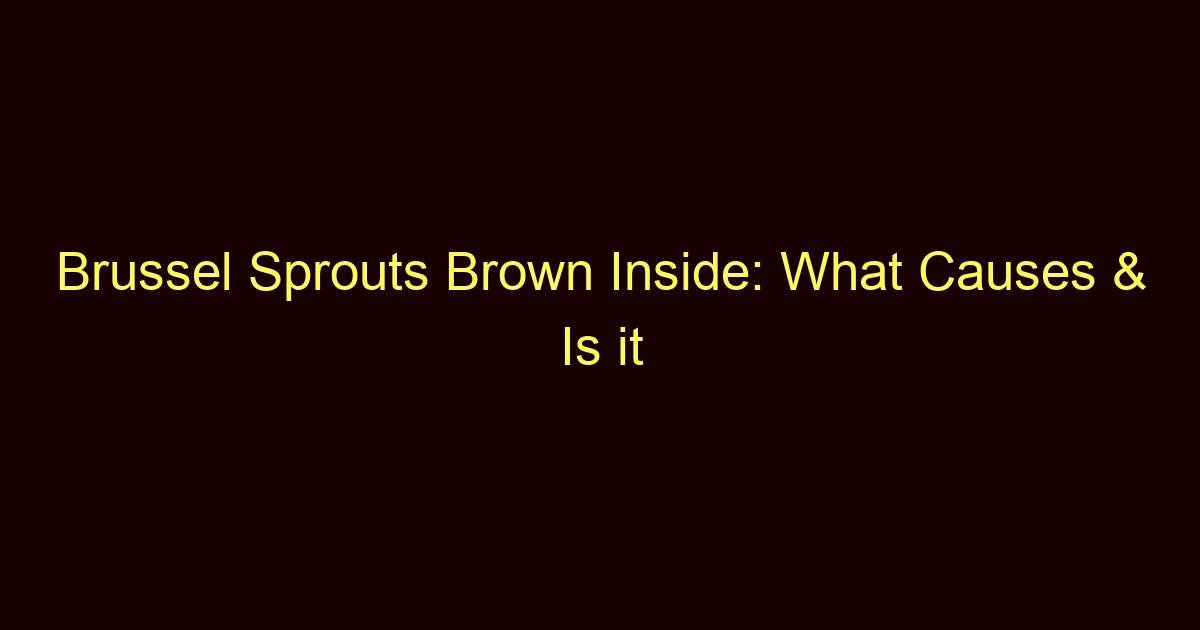Answer: Brussel sprouts may turn brown inside due to oxidation, age, or improper storage. Generally, it’s safe to eat them if they’re slightly brown, but if they smell bad or are mushy, it’s better to discard them.
Brussel sprouts, those mini cabbage-like veggies that you either love or hate, sometimes turn brown inside. If you’ve ever sliced one open to find a brown interior, you might’ve wondered if it’s still good to eat or what caused the browning. We’ve got answers for you.
Why Brussel Sprouts Brown Inside: Causes?
The primary causes for the inside of Brussel sprouts turning brown are oxidation, aging, and improper storage conditions.
Oxidation is the same process that turns a sliced apple brown. Brussel sprouts are no exception to this rule. When you slice them open, you expose their inner flesh to air, causing them to brown over time. But it’s not just about the exposure to air. The enzymes inside the sprouts also play a role in the browning. Think of it as a natural defense mechanism for the vegetable, just like how our skin reacts to an external injury.
Aging is another culprit. As Brussel sprouts age, they naturally degrade, turning their lush green interior into a not-so-appealing brown. This is much like the graying of human hair; it’s a sign that the sprout has seen better days. Usually, this happens if the sprouts have been left for a long time after harvesting or if they have been stored improperly, which brings us to our next point.
Improper storage can also result in brown Brussel sprouts. If you’ve stuffed them way back in the fridge where they’re subjected to temperature fluctuations, or if they’ve been lounging in a humid environment, they’re likely to go brown faster. Ever left a loaf of bread out and found mold? It’s sort of the same idea.
Is Brussel Sprouts Brown Inside Safe to Eat?
Generally, slightly brown Brussel sprouts are safe to eat but if they smell bad or are mushy, it’s best to discard them.
So, you’ve got a brown Brussel sprout on your cutting board. Should you throw it out? Well, not necessarily. A slight brown tint doesn’t mean the sprout has gone bad. However, always apply the smell test. If it’s emitting a pungent, off odor, it’s best to bid it farewell. Bad smells are usually the first sign that the vegetable is no longer fresh.
What about texture? A Brussel sprout that’s gone bad will usually be mushy and unappealing to the touch. It’s like grabbing a rotten apple; you’ll know it’s bad as soon as you feel it. If the sprout has a mushy texture, it’s a sign that it’s time to let go.
If you’ve passed the smell and touch test but are still skeptical, cut away the brown parts before cooking. This is much like peeling away the bruised part of an apple. As long as the remaining portion smells and feels fine, it’s likely safe for consumption.
What Happens if You Eat Bad Brussel Sprouts?
Consuming bad Brussel sprouts can lead to food poisoning symptoms like vomiting, diarrhea, and stomach cramps.
If you end up eating Brussel sprouts that have gone bad, don’t expect your stomach to be thrilled. You’ll most likely experience the classic symptoms of food poisoning, like vomiting and diarrhea. It’s your body’s way of saying, “Hey, you shouldn’t have eaten that!”
More severe cases might involve more intense gastrointestinal issues and could require medical attention. Food poisoning isn’t just about an upset stomach; it can also lead to dehydration, which is a serious condition. If you suspect severe symptoms, seek medical help right away.
However, the chances of facing severe repercussions from eating bad Brussel sprouts are relatively low compared to other high-risk foods like raw meat. Still, it’s better to be safe than sorry. Always apply common sense and scrutinize the veggies before consuming them.
Final Thoughts
After reading this article, you should be well-equipped to deal with the mystery of brown Brussel sprouts. Oxidation, aging, and improper storage are the primary villains. However, slight browning doesn’t usually signal a health risk, unless accompanied by a bad smell or mushy texture.
For the daring souls who take the risk and ignore the warning signs, be prepared for the potential repercussions. Although severe food poisoning is unlikely, consuming bad Brussel sprouts can still lead to an unpleasant experience that might involve a bathroom trip or two.
So the next time you encounter a brown Brussel sprout, you’ll know what to do. Inspect, sniff, and touch. And if it passes all three tests, go ahead and enjoy your meal. After all, Brussel sprouts are packed with nutrients and should not be wasted if they’re still good to eat.

